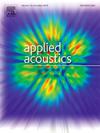Urban traffic flow estimation with noise measurements using log-linear regression
IF 3.4
2区 物理与天体物理
Q1 ACOUSTICS
引用次数: 0
Abstract
This study proposes the determination of a log-linear regression model for estimating average traffic flow rates using a single measured noise indicator. This model was trained and tested with noise and traffic count data collected over 400 days at a case study location in central Stockholm, Sweden. Through a comprehensive analysis of the correlation between various noise indicators and traffic counts, the best performing indicator was selected, enabling traffic flow estimation with an average day-wise RMSE of 2.31 vehicles per minute and percentage error of 7%. Different measurement campaign strategies were tested to assess their effectiveness in providing reliable training data, demonstrating that campaigns measuring over all hours of the day and all days of the week perform significantly better than campaigns restricted to typical weekday working hours. This study highlights the potential of noise-based traffic estimation as a complementary, cost-effective approach for enhancing real-time traffic monitoring and transportation assessment.

求助全文
约1分钟内获得全文
求助全文
来源期刊

Applied Acoustics
物理-声学
CiteScore
7.40
自引率
11.80%
发文量
618
审稿时长
7.5 months
期刊介绍:
Since its launch in 1968, Applied Acoustics has been publishing high quality research papers providing state-of-the-art coverage of research findings for engineers and scientists involved in applications of acoustics in the widest sense.
Applied Acoustics looks not only at recent developments in the understanding of acoustics but also at ways of exploiting that understanding. The Journal aims to encourage the exchange of practical experience through publication and in so doing creates a fund of technological information that can be used for solving related problems. The presentation of information in graphical or tabular form is especially encouraged. If a report of a mathematical development is a necessary part of a paper it is important to ensure that it is there only as an integral part of a practical solution to a problem and is supported by data. Applied Acoustics encourages the exchange of practical experience in the following ways: • Complete Papers • Short Technical Notes • Review Articles; and thereby provides a wealth of technological information that can be used to solve related problems.
Manuscripts that address all fields of applications of acoustics ranging from medicine and NDT to the environment and buildings are welcome.
 求助内容:
求助内容: 应助结果提醒方式:
应助结果提醒方式:


